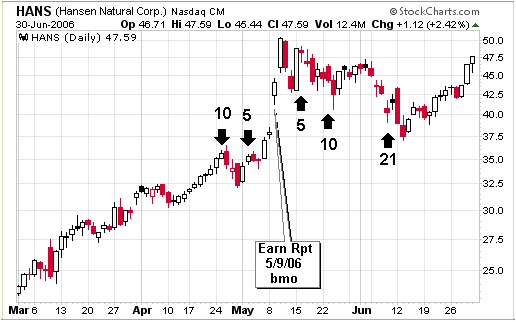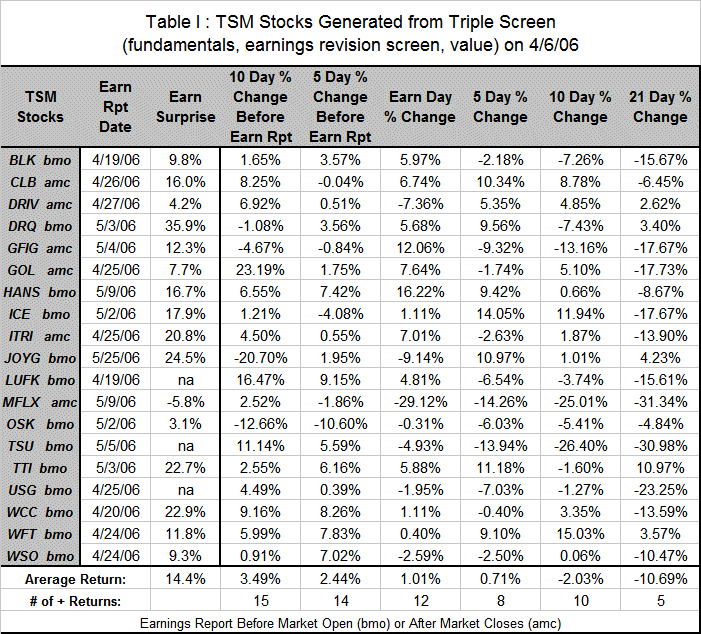TripleScreenMethod.com
Holding Quality Stocks Through Their Earnings Report
from www.CANSLIM.net (published September 2006)
Richard W. Miller, Ph.D.
Trading fundamentally sound stocks differs from simply trading patterns without regard to fundamentals. Hence, technical characteristics like breakouts and pullbacks may well exhibit different probabilities and preferred trading patterns for this select group of stocks. Over the years, I’ve highlighted these kinds of differences here in earlier CANSLIM.net issues (technical pattern probabilities for breakouts, pullbacks, new 21 day highs and new 21 day lows in Oct ’04, Nov ’04, Mar ’05, Sept ’05 and Oct ’05 issues). In this issue, I discuss the characteristic price variations of these fundamentally sound stocks leading up to and taken through their earnings report. Should one hold one of these fundamentally sound stocks through such a report or trade it? That’s the crux of the question.
Ultimately a stock’s price depends on its earnings and its PE ratio, the latter because a stock’s earnings dollar is worth more when it grows at a greater rate. Additionally, there’s a phenomenon called “post earnings report drift” that finds stocks reporting a positive earnings surprise tend to continue their price gains at least until their next earnings report. This happens because institutional buying takes time to reflect a stock’s new worth. Of course, the opposite is true as well, i.e., a negative earning surprise causes a stock to drift lower until the next report period.
Intuitively, one would expect a stock with strong fundamentals to exhibit a price rise into its earnings report on the expectation of a good report then, if it delivers a positive earnings surprise, to climb into its next earnings report—at least until its price reflects the new earnings expectation. Table I charts price performance through the 1st quarter earnings report for 19 stocks, all TSM screened for fundamentals, earnings revision fuel and value on 4/6/06. On average 16 of these 19 delivered a 14.4 percent positive earnings surprise.
Six sets of returns are charted in the Table. The intent is to characterize possible trading strategies for trading period through an earnings report. While I recognize the limited scope of the sample as well as the influence market conditions can play on a stock’s price performance, I think some patterns observed for these fundamentally sound stocks are significant. Further testing will validate these findings.
Returns are shown for five holding periods (all transactions made at day’s close): buy 10 days before the earnings report issues and close it out on the day before it issues; buy 5 days before the report issues and close it out on the day before it issues; buy the day before the earnings report issues and sell the next day; buy the day the earnings report issues and sell 5 days later; buy the day the earnings report issues and sell 10 days later. The chart shows the five strategies of HANS. Note the large positive gap on the 16.7 percent earning’s surprise.

Buying either period preceding the report yielded significant positive returns as buyers drove prices higher on the expectation of quality earnings: 19 stocks averaged a 3.49 percent gain for the 10 day hold period and a 2.44 percent gain for the 5 day hold period. In the first case 15 of 19 delivered a positive return (significant at the 99 percent level of confidence), while the second had 14 of 19 delivering a positive return (significant at the 96.8 percent level of confidence). On the other hand, holding over the report period or 5 days beyond delivered an additional 1 and 0.7 percent return, respectively, though neither exhibited a significant preference for delivering a positive return. Holding 10 or 21 days beyond the report date lost money on average, and the later exhibited a significant tendency to lose money with 14 of 19 stocks delivering negative returns (again, significant at the 96.8 percent level of confidence).
While further study is needed to verify the strategy, one positive approach to trading fundamentally sound stocks is to buy a group (say 20), diversified across sectors, 10 days before their respective earnings report date, then sell them on the day before the report. If you want to hold the positions longer (those exhibiting the largest earnings surprise to take advantage of the “post earnings report drift,” consider repurchasing 21 days after the report issues. An excellent approach to trading this strategy-one which minimizes transaction costs--is through a folio account which offers inexpensive window trades and partial share purchases (see foliofn.com). Too, I would control downside risk by using a 5 percent stop loss, i.e., not incurring JOYG’s 20.7 percent loss. There you have it, a method to trade fundamentally sound stocks. I’ll report the results following next quarter’s earnings reports.
